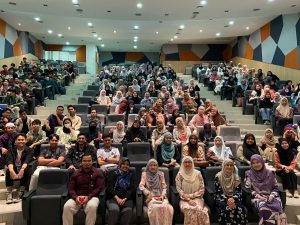
An insightful hybrid lecture took place in DKDI of Pusat Asasi UiTM Cawangan Selangor Kampus Dengkil on the 9th November 2023. Invited speaker, Dr. Khairiza Lubis who is currently the Head of Biology Department, Faculty of Mathematics and Natural Sciences, Universitas Negeri Medan, Indonesia, delivered a collaborative lecture that delved into the topic “Biodiversity: Love The Nature”. This significant mass lecture drew audience of more than 200 students, all eager to gain a deeper understanding on the topic. It was also broadcasted in the Pusat Asasi Youtube channel.
Dr. Khairiza stated the Linnaean classification, a hierarchical classification system that was developed in the 1700s by Carolus Linnaeus, and being used widely until today. She explained the components of the six-kingdom system of classification developed by Woese, which was based on evolutional and molecular genetics and included the Woese’s Domain system, which is based on molecular biology study.
During her lecture, Dr. Khairiza explained the essential role of taxonomy to futher understand and preserve biodiversity. She also highlighted how proper species classification is vital in conservation efforts, and outlined how taxonomy contributes to the core of biodiversity studies. Taxonomy is a scientific discipline that organizes organisms in a hierarchical manner, based on shared characteristics and analytic categories. It is used to systematically classify organisms and facilitate communication among scientists. This system assists during identifying and naming of new species which supports in terms of understanding of the diversity of life on Earth. She also described the binomial nomenclature, a two-term naming system that uses two different terms to name species of plants, animals, and other living organisms. Students were also exposed on various nomenclatural types such as holotype, isotype, lectotype, neotype, and syntype.
Dr. Khairiza mentioned on the importance of biodiversity, being in situ and ex situ conservation. In situ conservation refers to the practice of preserving and protecting natural habitats and ecosystems in their original, natural state. As she described interesting places in Indonesia and began sharing images of Taman Nasional Komodo and Taman Nasional Gunung Leuser Sumatera, the students instantaneously became intrigued causing this to be the highlight of the session.
Other interesting places she mentioned includes The Komodo National Park, which is recognized as UNESCO World Heritage Site. Students were ecstatic to see images of Komodo dragons (a monitor lizard, almost three metre in length) which are endemic to the Komodo Island and several neighbouring islands. Meanwhile, ex-situ conservation, refers to the practice of removing endangered species from their natural habitats and relocating them to a captive environment such as in Kebun Raya Cibodas and Kebun Raya Bogor.
During her closing remarks, Dr. Khairiza emphasized that a robust understanding of taxonomy is essential for professionals in order to achieve sustainable biodiversity practices. She encouraged future collaborations among academicians especially with the Biology Unit of Pusat Asasi and researchers to ensure a unified approach towards preserving unique ecosystems of Malaysia and Indonesia.
